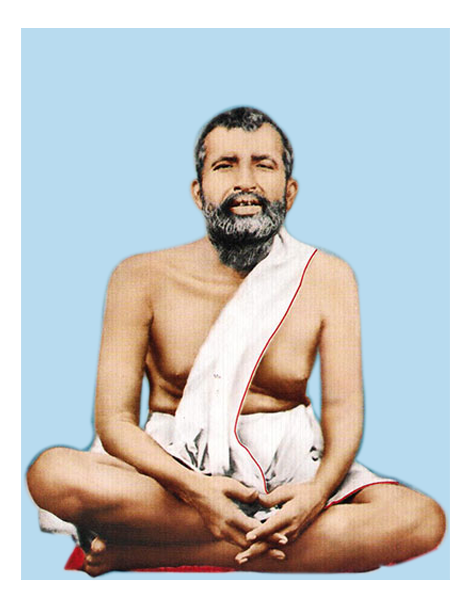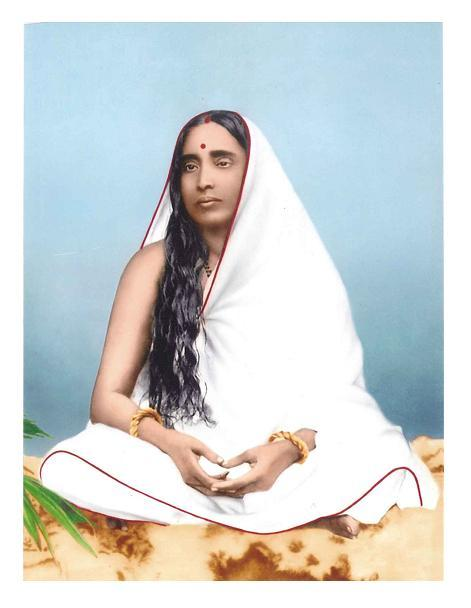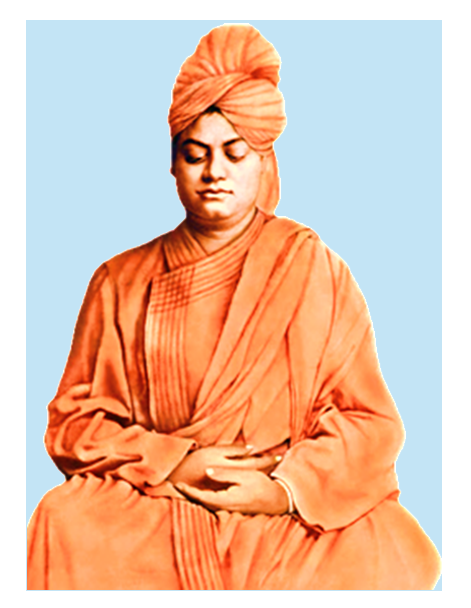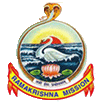Our Inspiration

Sri Ramakrishna was born on 18 February 1836 in the village of Kamarpukur about sixty miles northwest of Kolkata. His parents, Kshudiram Chattopadhyaya and Chandramani Devi, were poor but very pious and virtuous. As a child, Ramakrishna (his childhood name was Gadadhar) was dearly loved by the villagers. From early days, he was disinclined towards formal education and worldly affairs. He was, however, a talented boy, and could sing and paint well. He was fond of serving holy men and listening to their discourses. He was also very often found to be absorbed in spiritual moods. At the age of six, he experienced the first ecstasy while watching a flight of white cranes moving against the background of black clouds. This tendency to enter into ecstasy intensified with age. His father's death when he was seven years old served only to deepen his introspection and increase his detachment from the world.
As a Priest at Dakshineswar Temple
When Sri Ramakrishna was sixteen, his brother Ramkumar took him to Kolkata to
assist him in his priestly profession. In 1855 the Kali Temple at Dakshineswar built by
Rani Rasmani was consecrated and Ramkumar became the chief priest in that temple. When
he died a few months later, Ramakrishna was appointed the priest. Ramakrishna developed
intense devotion to Mother Kali and spent hours in loving adoration of her image,
forgetting the rituals of priestly duties. His intense longing culminated in the vision
of Mother Kali as boundless effulgence engulfing everything around him.
Intense Spiritual Practices
Sri Ramakrishna God-intoxicated state alarmed his relatives in Kamarpukur and
they got him married to Saradamani, a girl from the neighbouring village of Jayrambati.
Unaffected by the marriage, Sri Ramakrishna plunged into even more intense spiritual
practices. Impelled by a strong inner urge to experience different aspects of God he
followed, with the help of a series of Gurus, the various paths described in the Hindu
scriptures, and realized God through each of them. The first teacher to appear at
Dakshineswar (in 1861) was a remarkable woman known as Bhairavi Brahmani who was an
advanced spiritual adept, well versed in scriptures. With her help Sri Ramakrishna
practised various difficult disciplines of the Tantrik path, and attained success in all
of them. Three years later came a wandering monk by name Totapuri, under whose guidance
Sri Ramakrishna attained Nirvikalpa Samadhi, the highest spiritual experience mentioned
in the Hindu scriptures. He remained in that state of non-dual existence for six months
without the least awareness of even his own body. In this way, Sri Ramakrishna relived
the entire range of spiritual experiences of more than three thousand years of Hindu
religion.
Following Other Faiths
With his unquenchable thirst for God, Sri Ramakrishna broke the frontiers of
Hinduism, glided through the paths of Islam and Christianity, and attained the highest
realization through each of them in a short span of time. He looked upon Jesus and
Buddha as incarnations of God, and venerated the ten Sikh Gurus. He expressed the
quintessence of his twelve-year-long spiritual realizations in a simple dictum: Yato
mat, tato path As many faiths, so many paths? He now habitually lived in an exalted
state of consciousness in which he saw God in all beings.
Worshipping His Wife
In 1872, his wife Sarada, now nineteen years old, came from the village to meet
him. He received her cordially, and taught her how to attend to household duties and at
the same time lead an intensely spiritual life. One night he worshipped her as the
Divine Mother in his room at the Dakshineswar temple. Although Sarada continued to stay
with him, they lived immaculately pure lives, and their marital relationship was purely
spiritual. It should be mentioned here that Sri Ramakrishna had been ordained a
Sannyasin (Hindu monk), and he observed the basic vows of a monk to perfection. But
outwardly he lived like a lay man, humble, loving and with childlike simplicity. During
Sri Ramakrishna stay at Dakshineswar, Rani Rasmani first acted as his patron. After her
death, her son-in-law Mathur Nath Biswas took care of his needs.
Contact with Some Notables
Sri Ramakrishna name as an illumined saint began to spread. Mathur once convened
an assembly of scholars, and they declared him to be not an ordinary human being but the
Avatar of the Modern Age. In those days the socio-religious movement known as Brahmo
Samaj, founded by Raja Ram Mohan Roy, was at the height of popularity in Bengal. Sri
Ramakrishna came into contact with several leaders and members of Brahmo Samaj and
exerted much influence on them. His teaching on harmony of religions attracted people
belonging to different denominations, and Dakshineswar became a veritable Parliament of
Religions.
Coming of the Devotees
As bees swarm around a fully blossomed flower, devotees now started coming to Sri
Ramakrishna. He divided them into two categories. The first one consisted of
householders. He taught them how to realize God while living in the world and
discharging their family duties. The other more important category was a band of
educated youths, mostly from the middle class families of Bengal, whom he trained to
become monks and to be the torchbearers of his message to mankind. The foremost among
them was Narendranath, who years later, as Swami Vivekananda, carried the universal
message of Vedanta to different parts of the world, revitalized Hinduism, and awakened
the soul of India.
The Gospel of Sri Ramakrishna
Sri Ramakrishna did not write any book, nor did he deliver public lectures.
Instead, he chose to speak in a simple language using parables and metaphors by way of
illustration, drawn from the observation of nature and ordinary things of daily use. His
conversations were charming and attracted the cultural elite of Bengal. These
conversations were noted down by his disciple Mahendranath Gupta who published them in
the form of a book, Sri Sri Ramakrishna Kathamrita in Bengali. Its English rendering,
The Gospel of Sri Ramakrishna, was released in 1942; it continues to be increasingly
popular to this day on account of its universal appeal and relevance.
Last Days
The intensity of his spiritual life and untiring spiritual ministration to the
endless stream of seekers told on Sri Ramakrishna's health. He developed cancer of the
throat in 1885. He was shifted to a spacious suburban villa where his young disciples
nursed him day and night. He instilled in them love for one another, and thus laid the
foundation for the future monastic brotherhood known as Ramakrishna Math. In the small
hours of 16 August 1886 Sri Ramakrishna gave up his physical body, uttering the name of
the Divine Mother, and passed into Eternity.

Endearingly known as Holy Mother Sri Sarada Devi, the spiritual consort of Sri
Ramakrishna, was born on 22 December 1853 in a poor Brahmin family in Jayrambati, a
village adjoining Kamarpukur in West Bengal. Her father, Ramachandra Mukhopadhyay, was a
pious and kind-hearted person, and her mother, Shyama Sundari Devi, was a loving and
hard-working woman.
Marriage
As a child Sarada was devoted to God, and spent most of her time helping her
mother in various household chores like caring for younger children, looking after
cattle and carrying food to her father and others engaged in work in the field. She had
no formal schooling, but managed to learn the Bengali alphabet. When she was about six
years old, she was married to Sri Ramakrishna, according to the custom prevalent in
India in those days. However, after the event, she continued to live with her parents,
while Sri Ramakrishna lived a God-intoxicated life at Dakshineshwar.
Visit to Dakshineshwar
At the age of eighteen she walked all the way to Dakshineshwar to meet her
husband. Sri Ramakrishna, who had immersed himself in the intense practice of several
spiritual disciplines for more than twelve years, had reached the highest state of
realization in which he saw God in all beings. He received Sarada Devi with great
affection, and allowed her to stay with him. He taught her how to lead a spiritual life
while discharging her household duties. They led absolutely pure lives, and Sarada Devi
served Sri Ramakrishna as his devoted wife and disciple, while remaining a virgin nun
and following the spiritual path.
Life at Dakshineshwar
Sri Ramakrishna looked upon Sarada Devi as a special manifestation of Divine
Mother of the universe. In 1872, on the night of the Phala-harini-Kali-puja, he
ritualistically worshipped Sarada Devi as the Divine Mother, thereby awakening universal
Motherhood latent in her. When disciples began to gather around Sri Ramakrishna, Sarada
Devi learned to look upon them as her own children. The room in which she stayed at
Dakshineshwar was too small to live in and had hardly any amenities; and on many days
she did not get the opportunity of meeting Sri Ramakrishna. But she bore all
difficulties silently and lived in contentment and peace, serving the increasing number
of devotees who came to see Sri Ramakrishna.
Leading the Sangha after the Master Passing
After Sri Ramakrishna passing away in 1886, Sarada Devi spent some months in
pilgrimage, and then went to Kamarpukur where she lived in great privation. Coming to
know of this, the disciples of Sri Ramakrishna brought her to Kolkata. This marked a
turning point in her life. She now began to accept spiritual seekers as her disciples,
and became the open portal to immortality for hundreds of people. Her great universal
mother-heart, endowed with boundless love and compassion, embraced all people without
any distinction, including many who had lived sinful lives.
When the Western women disciples of Swami Vivekananda came to Kolkata, the Holy
Mother accepted them with open arms as her daughters, ignoring the restrictions of the
orthodox society of those days. Although she had grown up in a conservative rural
society without any access to modern education, she held progressive views, and
whole-heartedly supported Swami Vivekananda in his plans for rejuvenation of India and
the uplift of the masses and women. She was closely associated with the school for girls
started by Sister Nivedita. She spent her life partly in Kolkata and partly in her
native village Jayrambati. During the early years of her stay in Kolkata, her needs were
looked after by Swami Yogananda, a disciple of Sri Ramakrishna. In later years her needs
were looked after by another disciple of Sri Ramakrishna, Swami Saradananda, who built a
new house for her in Kolkata.
Simplicity and Forbearance
Although she was highly venerated for her spiritual status, and literally
worshipped as the Divine Mother, she continued to live like a simple village mother,
washing clothes, sweeping the floor, bringing water from the pond, dressing vegetables,
cooking and serving food. At Jayrambati she lived with her brothers and their families.
They gave her endless troubles but, established as she was in the awareness of God and
in Divine Motherhood, she always remained calm and self-possessed, showering love and
blessings on all who came into contact with her. As Sister Nivedita stated, Her life was
one long stillness of prayer.?
Mother of All
In the history of humanity there has never been another woman who looked upon
herself as the Mother of all beings, including animals and birds, and spent her whole
life in serving them as her children, undergoing unending sacrifice and self-denial.
About her role in the mission of Sri Ramakrishna on earth, she stated: “My son, you
know the Master had a maternal attitude (matri-bhava) towards every one. He has left me
behind to manifest that Divine Motherhood in the world.�
Ideal Women
On account of her immaculate purity, extraordinary forbearance, selfless service,
unconditional love, wisdom and spiritual illumination, Swami Vivekananda regarded Sri
Sarada Devi as the ideal for women in the modern age. He believed that with the advent
of Holy Mother, the spiritual awakening of women in modern times had begun.
Last Days
Under the strain of constant physical work and self-denial and repeated attacks
of malaria, her health deteriorated in the closing years of her life, and she left the
mortal world on 21 July 1920.

My son, if a thorn pricks your foot, it hurts me like a spear entering my heart. Never fear, and whenever you are in distress just say to yourself, "I have a mother"
Swami Vivekananda, known in his pre-monastic life as Narendra Nath Datta, was born in an affluent family in Kolkata on 12 January 1863. His father, Vishwanath Datta, was a successful attorney with interests in a wide range of subjects, and his mother, Bhuvaneshwari Devi, was endowed with deep devotion, strong character and other qualities. A precocious boy, Narendra excelled in music, gymnastics and studies. By the time he graduated from Calcutta University, he had acquired a vast knowledge of different subjects, especially Western philosophy and history. Born with a yogic temperament, he used to practise meditation even from his boyhood, and was associated with Brahmo Movement for some time.
With Sri Ramakrishna
At the threshold of youth Narendra had to pass through a period of spiritual
crisis when he was assailed by doubts about the existence of God. It was at that time he
first heard about Sri Ramakrishna from one of his English professors at college. One day
in November 1881, Narendra went to meet Sri Ramakrishna who was staying at the Kali
Temple in Dakshineshwar. He straightaway asked the Master a question which he had put to
several others but had received no satisfactory answer: “Sir, have you seen God?
Without a moment’s hesitation, Sri Ramakrishna replied: “Yes, I have. I see Him as
clearly as I see you, only in a much intenser sense? Apart from removing doubts from the
mind of Narendra, Sri Ramakrishna won him over through his pure, unselfish love. Thus
began a guru-disciple relationship which is quite unique in the history of spiritual
masters. Narendra now became a frequent visitor to Dakshineshwar and, under the guidance
of the Master, made rapid strides on the spiritual path. At Dakshineshwar, Narendra also
met several young men who were devoted to Sri Ramakrishna, and they all became close
friends.
Difficult Situations
After a few years two events took place which caused Narendra considerable
distress. One was the sudden death of his father in 1884. This left the family
penniless, and Narendra had to bear the burden of supporting his mother, brothers and
sisters. The second event was the illness of Sri Ramakrishna which was diagnosed to be
cancer of the throat. In September 1885 Sri Ramakrishna was moved to a house at
Shyampukur, and a few months later to a rented villa at Cossipore. In these two places
the young disciples nursed the Master with devoted care. In spite of poverty at home and
inability to find a job for himself, Narendra joined the group as its leader.
Beginnings of a Monastic Brotherhood
Sri Ramakrishna instilled in these young men the spirit of renunciation and
brotherly love for one another. One day he distributed ochre robes among them and sent
them out to beg food. In this way he himself laid the foundation for a new monastic
order. He gave specific instructions to Narendra about the formation of the new monastic
Order. In the small hours of 16 August 1886 Sri Ramakrishna gave up his mortal body.
After the Master’s passing, fifteen of his young disciples (one more joined them
later) began to live together in a dilapidated building at Baranagar in North Kolkata.
Under the leadership of Narendra, they formed a new monastic brotherhood, and in 1887
they took the formal vows of sannyasa, thereby assuming new names. Narendra now became
Swami Vivekananda (although this name was actually assumed much later.)
Awareness of Life Mission
After establishing the new monastic order, Vivekananda heard the inner call for a
greater mission in his life. While most of the followers of Sri Ramakrishna thought of
him in relation to their own personal lives, Vivekananda thought of the Master in
relation to India and the rest of the world. As the prophet of the present age, what was
Sri Ramakrishna’s message to the modern world and to India in particular? This
question and the awareness of his own inherent powers urged Swamiji to go out alone into
the wide world. So in the middle of 1890, after receiving the blessings of Sri Sarada
Devi, the divine consort of Sri Ramakrishna, known to the world as Holy Mother, who was
then staying in Kolkata, Swamiji left Baranagar Math and embarked on a long journey of
exploration and discovery of India.
Discovery of Real India
During his travels all over India, Swami Vivekananda was deeply moved to see the
appalling poverty and backwardness of the masses. He was the first religious leader in
India to understand and openly declare that the real cause of India's downfall was the
neglect of the masses. The immediate need was to provide food and other bare necessities
of life to the hungry millions. For this they should be taught improved methods of
agriculture, village industries, etc. It was in this context that Vivekananda grasped
the crux of the problem of poverty in India (which had escaped the attention of social
reformers of his days): owing to centuries of oppression, the downtrodden masses had
lost faith in their capacity to improve their lot. It was first of all necessary to
infuse into their minds faith in themselves. For this they needed a life-giving,
inspiring message. Swamiji found this message in the principle of the Atman, the
doctrine of the potential divinity of the soul, taught in Vedanta, the ancient system of
religious philosophy of India. He saw that, in spite of poverty, the masses clung to
religion, but they had never been taught the life-giving, ennobling principles of
Vedanta and how to apply them in practical life. Thus the masses needed two kinds of
knowledge: secular knowledge to improve their economic condition, and spiritual
knowledge to infuse in them faith in themselves and strengthen their moral sense. The
next question was, how to spread these two kinds of knowledge among the masses? Through
education â€" this was the answer that Swamiji found.
Need for an Organization
One thing became clear to Swamiji: to carry out his plans for the spread of
education and for the uplift of the poor masses, and also of women, an efficient
organization of dedicated people was needed. As he said later on, he wanted to set in
motion a machinery which will bring noblest ideas to the doorstep of even the poorest
and the meanest.? It was to serve as this machinery that Swamiji founded the Ramakrishna
Mission a few years later.
Decision to attend the Parliament of Religions
It was when these ideas were taking shape in his mind in the course of his
wanderings that Swami Vivekananda heard about the World’s Parliament of Religions to
be held in Chicago in 1893. His friends and admirers in India wanted him to attend the
Parliament. He too felt that the Parliament would provide the right forum to present his
Master message to the world, and so he decided to go to America. Another reason which
prompted Swamiji to go to America was to seek financial help for his project of
uplifting the masses. Swamiji, however, wanted to have an inner certitude and divine
call regarding his mission. Both of these he got while he sat in deep meditation on the
rock-island at Kanyakumari. With the funds partly collected by his Chennai disciples and
partly provided by the Raja of Khetri, Swami Vivekananda left for America from Mumbai on
31 May 1893.
The Parliament of Religions and After
His speeches at the WorldParliament of Religions held in September 1893 made him
famous as an orator by divine right and as a Messenger of Indian wisdom to the Western
world After the Parliament, Swamiji spent nearly three and a half years spreading
Vedanta as lived and taught by Sri Ramakrishna, mostly in the eastern parts of USA and
also in London.
Founding of Ramakrishna Mission
Soon after his return to Kolkata, Swami Vivekananda accomplished another
important task of his mission on earth. He founded on 1 May 1897 a unique type of
organization known as Ramakrishna Mission, in which monks and lay people would jointly
undertake propagation of Practical Vedanta, and various forms of social service, such as
running hospitals, schools, colleges, hostels, rural development centres etc, and
conducting massive relief and rehabilitation work for victims of earthquakes, cyclones
and other calamities, in different parts of India and other countries.
Disciples
It may be mentioned here that in the West many people were influenced by Swami
Vivekananda life and message. Some of them became his disciples or devoted friends.
Among them the names of Margaret Noble (later known as Sister Nivedita), Captain and Mrs
Sevier, Josephine McLeod and Sara Ole Bull, deserve special mention. Nivedita dedicated
her life to educating girls in Kolkata. Swamiji had many Indian disciples also, some of
whom joined Ramakrishna Math and became sannyasins.
Last Days
In June 1899 he went to the West on a second visit. This time he spent most of
his time in the West coast of USA. After delivering many lectures there, he returned to
Belur Math in December 1900. The rest of his life was spent in India, inspiring and
guiding people, both monastic and lay. Incessant work, especially giving lectures and
inspiring people, told upon Swamiji health. His health deteriorated and the end came
quietly on the night of 4 July 1902. Before his Mahasamadhi he had written to a Western
follower: It may be that I shall find it good to get outside my body, to cast it off
like a worn out garment. But I shall not cease to work. I shall inspire men everywhere
until the whole world shall know that it is one with God.?

